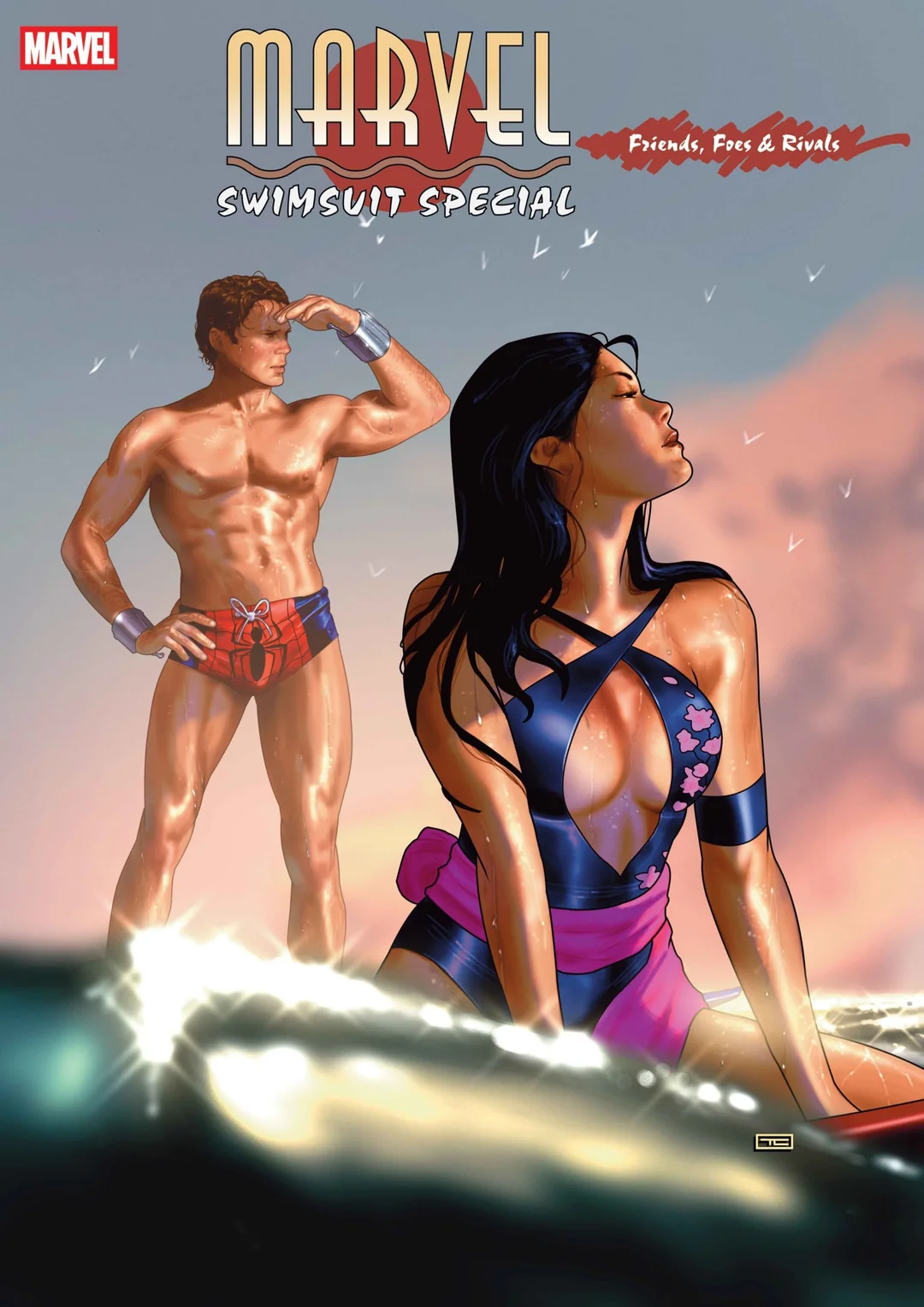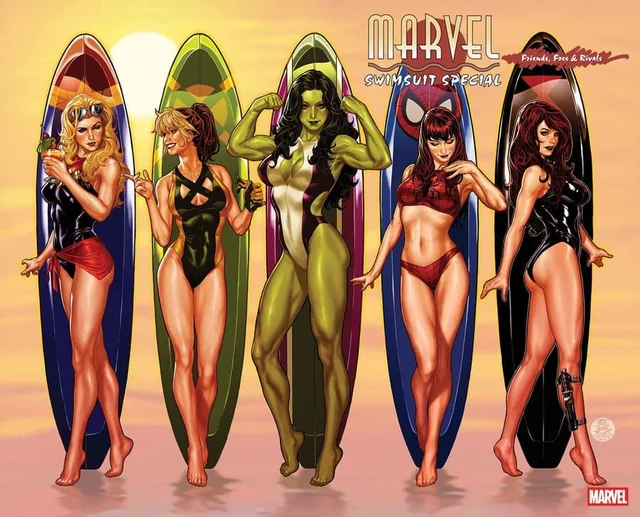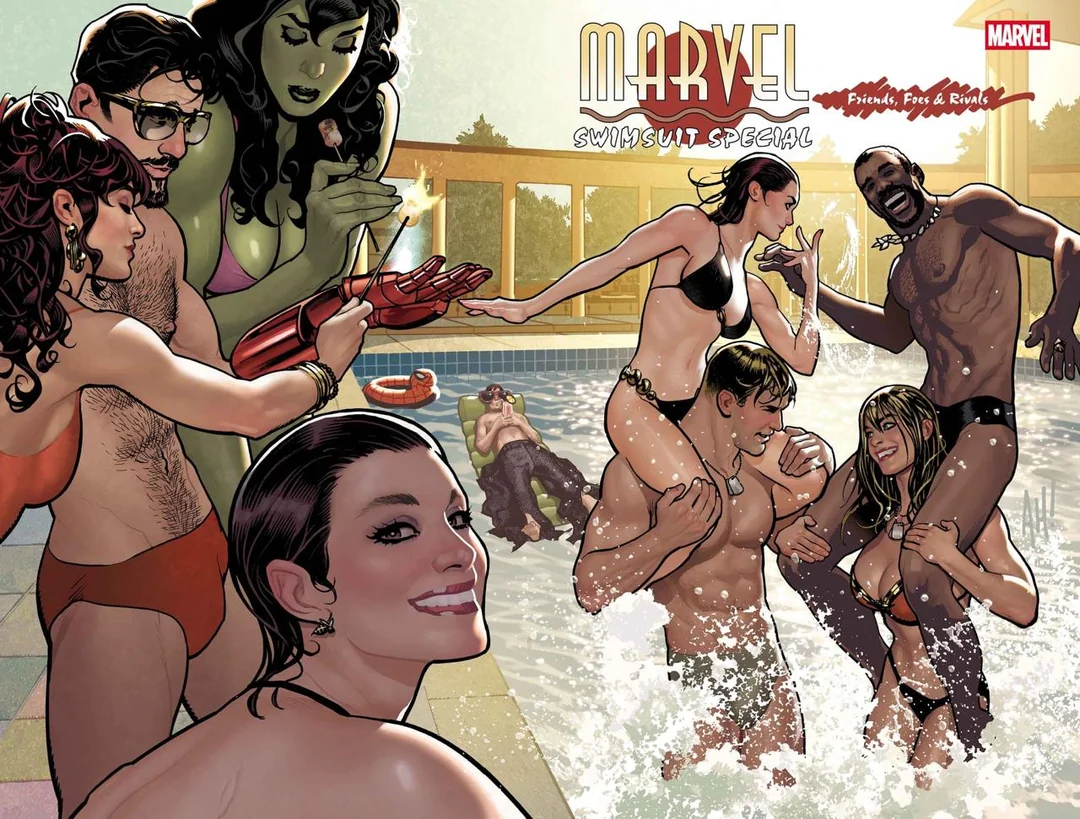Marvel Rivals burst onto the scene with a launch that turned heads across the industry. It racked up a massive 644,269 concurrent players on Steam during its Season 1 debut, instantly becoming one of the most-watched hero shooters of the year. But like many games with explosive starts, the numbers have cooled off. The game has reportedly lost more than 400,000 daily active players since its peak, raising questions about its long-term staying power.
Yet there’s reason to believe the fire hasn’t burned out — and the developers at NetEase are betting big on a different kind of heat to reignite interest: swimsuit skins.
Summer Update: Swimsuit Skins Inspired by Marvel’s ’90s Legacy

In a surprise cross-media collaboration, Marvel announced the return of its iconic Marvel Swimsuit Special with a brand-new comic titled “Friends, Foes & Rivals #1”, releasing on July 9, 2025. Alongside this nostalgic revival comes a wave of swimsuit-themed skins for Marvel Rivals, injecting fun, sun-soaked flair into the game’s seasonal offerings.
These skins are expected to launch with Season 3, likely hitting sometime in July or August 2025, aligning with the comic’s debut. This is more than just cosmetic fan service — it’s a calculated move to tap into retro comic culture while reviving interest in the game.
Confirmed and Teased Swimsuit Skins
Here’s a rundown of the confirmed and teased characters set to get summer-ready:

| Character | Status | Details |
|---|---|---|
| Squirrel Girl | Confirmed | Fun, quirky beach outfit |
| The Thing | Confirmed | Rocking a classic speedo |
| Jeff the Land Shark | Confirmed | Yes, even Jeff gets a floatie! |
| Black Widow | Teased | Shown in preview art |
| Psylocke | Teased | Expected to reference comic look |
| Spider-Man | Teased | Possible tank top boardshorts |
| Black Panther | Teased | Sleeveless, Wakandan summer style |
| Iron Man | Teased | Futuristic swimwear armor |
| Captain America | Teased | Patriot-themed beach attire |
| She-Hulk, Jean Grey, Rogue, Cyclops, Captain Marvel, Wasp | Speculated | Appear in comic previews |
These skins are not only rooted in nostalgia but also serve as clever fan engagement tools — a tactic successfully used in games like Overwatch and Fortnite, where seasonal events drive spikes in engagement and cosmetics sales.
Player Numbers: From Peak Hype to Reality Check
While some may look at the 400,000-player drop as a sign of trouble, it’s worth considering the broader context. Marvel Rivals still outpaces many games in its genre in terms of daily active users. The game has surpassed 40 million total players globally, a figure most online shooters can only dream of reaching.

This trajectory mirrors patterns seen in other competitive multiplayer titles: high initial curiosity, followed by a dip as casual players move on, and then a slow rebuild as core fans settle in. With consistent seasonal content, better balance updates, and now fan-service-rich cosmetics, Marvel Rivals could very well be positioning itself for long-term relevance.
What’s Next for Marvel Rivals?
In addition to the swimsuit skins, leaks and datamines hint at upcoming new characters, a 3v3 limited-time mode, and expanded controller support, aimed at making the game more accessible across platforms. There’s also growing speculation that a console version may be in development, which could dramatically expand the player base and shake up the competitive landscape.
Marvel Rivals may have hit a rough patch post-launch, but the summer content — including these fun swimsuit skins — signals that NetEase and Marvel are far from done. The next few months will be crucial in determining whether the game’s community rallies or fades, but if there’s one thing clear, it’s this: Marvel Rivals is still in the fight, and it’s bringing its best beachwear.
Key Takeaways
- Marvel Rivals set a record with over 644,000 concurrent players but has since experienced a substantial decline in its player base.
- Despite the drop, Marvel Rivals still outperforms many competitor games in terms of daily active users.
- Player count fluctuations are normal for new games, with recent updates showing signs of potential stabilization.
Analysis of Marvel Rivals’ Decline
Marvel Rivals has experienced a significant drop in player numbers since its record-breaking launch earlier this year. The game’s trajectory shows typical patterns of player attrition, though with some unique characteristics compared to industry standards.
Historical Player Count Metrics
Marvel Rivals initially burst onto the scene with impressive numbers, peaking at over 445,000 concurrent players during its launch period. This strong start positioned it as one of the most successful hero shooter launches in recent years.
However, recent data indicates a consistent downward trend in the player base. The game has been experiencing approximately a 10% drop in players daily over the past few weeks. This steady decline has resulted in the current player count reaching an all-time low since launch.
Despite this decline, it’s worth noting that Marvel Rivals still maintains a substantial player base. The 24-hour peak numbers, though lower than initial figures, still outperform several competing titles in the same genre.
Comparative Industry Benchmarks
When viewed against industry standards, Marvel Rivals’ player retention actually shows some strengths. Most new competitive shooters typically lose more than half their player base within the first few weeks after launch.
In comparison, Marvel Rivals has experienced a more gradual decline. The game’s current performance, while showing a significant drop from peak numbers, remains relatively strong for its stage in the lifecycle.
Overwatch 2, one of Marvel Rivals’ main competitors, has seen its own player count drop by approximately 39% since Marvel Rivals launched. This competitive impact suggests that while Marvel Rivals is losing players, it’s still exerting influence in the market.
The ranked mode distribution reveals potential issues, with data showing over 100,000 players concentrated in lower competitive tiers. This imbalance could affect long-term engagement.
Factors Influencing Player Engagement
Several key elements appear to be affecting player retention in Marvel Rivals:
Content Updates: The transition to Season 1 hasn’t stemmed the player decline, suggesting that new content alone isn’t addressing core player concerns.
Game Balance: Hero balancing remains a challenge, with certain characters dominating the meta and potentially frustrating casual players.
Technical Performance: Frame rate issues and server stability on certain maps continue to impact the player experience.
Visual and Audio Design: While the superhero artwork and animations receive praise, some players report sound issues that affect competitive play.
The learning curve for new players also presents a challenge. The game’s depth is appreciated by dedicated fans but can be intimidating for casual players looking for quick entertainment.
Market Analysis and Competitor Performance
The hero shooter market remains highly competitive, with established titles like Overwatch 2 and newer entries competing for player attention. Marvel Rivals leverages its powerful IP to attract fans of the fictional world but faces the challenge of converting initial curiosity into lasting engagement.
Key competitors have responded to Marvel Rivals’ presence:
- Overwatch 2: Experienced a 39% player count drop after Marvel Rivals launched
- Other hero shooters: Accelerated seasonal content to retain player interest
- Battle royale titles: Continue to dominate overall player numbers in the competitive action game space
The superhero theme gives Marvel Rivals a unique position, but gameplay mechanics and community features ultimately drive long-term success. The game’s current decline follows industry patterns but doesn’t necessarily predict its future trajectory if developers can address core engagement issues.
Cultural and Economic Impacts
Marvel Rivals has created ripples beyond just player statistics, affecting both gaming culture and economic landscapes. The game’s influence spans from reshaping superhero narratives in interactive media to generating significant revenue streams for developers and merchandisers.
Influence on Comic Book and Gaming Culture
Marvel Rivals has bridged traditional comic book fandom with competitive gaming communities in unprecedented ways. The game’s character roster featuring iconic superheroes has introduced Marvel’s universe to gamers who might not have engaged with comics previously.
Gaming streamers and content creators have embraced Marvel Rivals, creating dedicated channels and tournaments that celebrate both gaming skill and superhero lore. This has reinforced Marvel’s cultural relevance across different entertainment mediums.
The game has also influenced how players engage with superhero narratives, shifting from passive consumption to active participation where they can embody their favorite characters in competitive settings. This interactive element has deepened fans’ connections to these characters.
Social media conversations about Marvel characters have increased significantly, with game-specific memes and discussions becoming part of broader pop culture discourse.
Economic Contributions to the Gaming Industry
Despite recent player count declines, Marvel Rivals’ economic impact remains substantial. NetEase reported significant revenue growth in their gaming department, with Marvel Rivals contributing to their $2.9 billion in total revenue.
The game achieved 40 million players, creating substantial direct revenue through:
- Battle pass purchases
- Character skins and cosmetics
- Premium game modes
Marvel Rivals has also stimulated adjacent markets:
- Gaming hardware upgrades
- Streaming equipment
- Professional competitive team sponsorships
The game’s success has influenced industry trends, with other developers now more willing to invest in superhero-themed competitive titles. This has created new job opportunities in game development, especially for those with experience in both competitive gaming mechanics and narrative design.
Role of Intellectual Property and Merchandising
Marvel’s licensing strategy with Rivals demonstrates the value of intellectual property in the gaming industry. The partnership with NetEase represents a carefully calculated approach to monetizing Marvel characters beyond traditional media.
Merchandising has expanded beyond the game itself to include:
- Limited edition collectibles
- Branded peripherals (headsets, controllers, keyboards)
- Apparel featuring game-specific versions of characters
Cross-promotion between the game and Marvel films/TV shows has created synergistic marketing opportunities. Character introductions often align with other Marvel content releases, maximizing visibility and cultural impact.
International markets, particularly in Asia where competitive gaming has stronger cultural footholds, have embraced both the game and its merchandise. This has introduced Marvel’s IP to new demographics and created additional revenue streams through region-specific collaborations.
Frequently Asked Questions
Players have raised several concerns about Marvel Rivals’ declining numbers. The game’s trajectory has sparked discussions about its future and potential recovery strategies.
What factors have contributed to the decline in players for Marvel Rivals?
Several factors appear to be driving the decline in Marvel Rivals’ player count. The initial hype surrounding the game’s launch has naturally settled, which is common for new releases.
Balance issues with certain characters have frustrated competitive players. Some have complained about matchmaking problems that create uneven gameplay experiences.
The lack of regular content updates has also contributed to player fatigue. Many users report completing available content quickly and finding little reason to return daily.
How does the current player count for Marvel Rivals compare to its peak statistics?
Marvel Rivals reached an impressive peak of 644,269 concurrent players on Steam. This record-breaking number showcased the game’s initial popularity and market potential.
Current numbers show a consistent decline of approximately 10% daily over recent weeks. The average player count has settled around 80,000 players, representing a significant drop from its earlier heights.
This decline pattern follows typical trends for new shooters, though Marvel Rivals appears to be losing players somewhat more rapidly than industry analysts expected.
What strategies is the development team implementing to re-engage the player base in Marvel Rivals?
The development team has announced a roadmap of content updates scheduled throughout 2025. These include new playable characters, maps, and game modes to refresh the experience.
They’ve implemented a more frequent patch cycle to address balance issues. Community feedback is being actively incorporated into these updates.
Special events with unique rewards are planned to coincide with Marvel film and TV releases. The team hopes these tie-ins will attract both new and returning players.
Are there any seasonal trends affecting Marvel Rivals’ player count fluctuations?
Spring traditionally sees lower engagement across many games as academic schedules intensify. The March-April period often shows natural dips in player engagement.
Competing game releases in early 2025 have drawn attention away from Marvel Rivals. Several high-profile titles launched during this same window are splitting the player base.
The upcoming summer months typically show increased gaming activity. Analysts predict Marvel Rivals may see a natural boost during this period.
How does the player count of Marvel Rivals affect its competitive scene and tournaments?
Lower player counts have extended queue times for ranked matches. This particularly impacts high-skill players who face increasingly limited opponent pools.
Tournament organizers have adjusted prize pools in response to decreased viewer interest. Some planned competitive events have been postponed until player numbers stabilize.
Professional teams remain committed but are watching trends closely. Several organizations have paused recruitment of new Marvel Rivals players until the game’s trajectory becomes clearer.
What are the implications of Marvel Rivals’ downward trend in players for the game’s long-term viability?
The development studio’s strong financial backing provides runway for recovery. Unlike smaller studios, they can sustain operations through temporary downturns.
Revenue projections have been adjusted based on current player retention data. In-game purchase patterns suggest core players remain engaged despite overall count decreases.
Industry experts note that many successful games experienced similar early challenges. Several popular titles recovered from initial declines through strategic updates and community engagement.






